第2章信号与系统分析基础1
- 格式:ppt
- 大小:954.00 KB
- 文档页数:66

各章习题及答案第一章绪论1 .举例说明什么是测控?答:(1) 测控例子:为了确定一端固定的悬臂梁的固有频率,我们可以采用锤击法对梁进行激振,再利用压电传感器、电荷放大器、波形记录器记录信号波形,由衰减的振荡波形便可以计算出悬臂梁的固有频率。
(2)结论:由本例可知:测控是指确定被测对象悬臂梁的属性—固有频率的全部操作,是通过一定的技术手段—激振、拾振、记录、数据处理等,获取悬臂梁固有频率的信息的过程。
2. 测控技术的任务是什么?答:测控技术的任务主要有:通过模型试验或现场实测,提高产品质量;通过测控,进行设备强度校验,提高产量和质量;监测环境振动和噪声,找振源,以便采取减振、防噪措施;通过测控,发现新的定律、公式等;通过测控和数据采集,实现对设备的状态监测、质量控制和故障诊断。
3. 以方框图的形式说明测控系统的组成,简述主要部分的作用。
测控系统方框图如下:(2)各部分的作用如下:●传感器是将被测信息转换成某种电信号的器件;●信号的调理是把来自传感器的信号转换成适合传输和处理的形式;●信号处理环节可对来自信号调理环节的信号,进行各种运算、滤波和分析;●信号显示、记录环节将来自信号处理环节的信号显示或存贮。
●模数(A/D)转换和数模(D/A)转换是进行模拟信号与数字信号相互转换,以便用计算机处理。
4.测控技术的发展动向是什么?传感器向新型、微型、智能型方向发展;测控仪器向高精度、多功能、小型化、在线监测、性能标准化和低价格发展;参数测量与数据处理向计算机为核心发展;5. A precise optional signal source can control the output power level to within 1%. A laser is controlled by an input current to yield the power output. A microprocessor controls the input current tothe laser. The microprocessor compares the desired power level with a measured signal proportional to the laser power output obtained from a sensor. Complete the block diagram representing thisclosed-loop control system shown in Fig E1.1, identifying the output, input, and measured variables and the control device.答:6. many luxury automobiles have thermostatically controlled air-conditioning system(恒温空调系统)for the comfort of the passengers. Sketch a block diagram of an air-condition temperature on a dashboard panel(仪表盘). Identify the function of each element of the thermostatically controlled cooling system.答:7. In the past, control systems used a human operator as part of a closed-loop control system. Sketch the block diagram of the valve control system shown in Fig. P1.2.答:8. The student-teacher learning process is inherently a feedback process intended to reduce the system error back model of the learning process and identify each block of the system.答:9. Automatic control of water level using a float level was used in the Middle East for a water clock. The water clock was used from sometime before Christ until the seventeenth century. Discuss the operation of the water clock, and establish how the float provides a feedback control that maintains the accuracy of the clock. Sketch a block diagram of the feedback system.答:第二章信号与系统分析基础1求周期方波的傅立叶级数(复指数函数形式),画出|c n|-ω和ϕ-ω图。
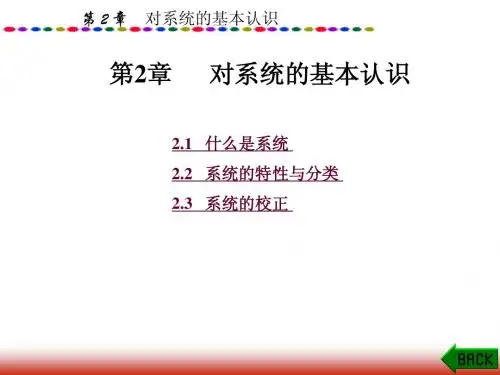
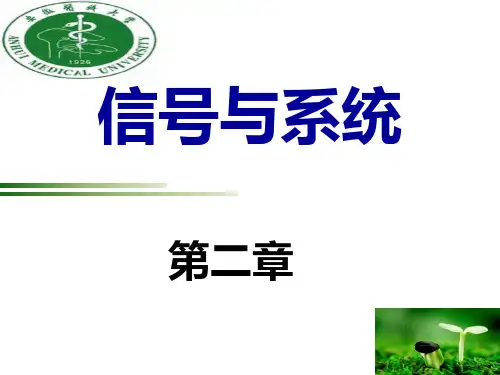
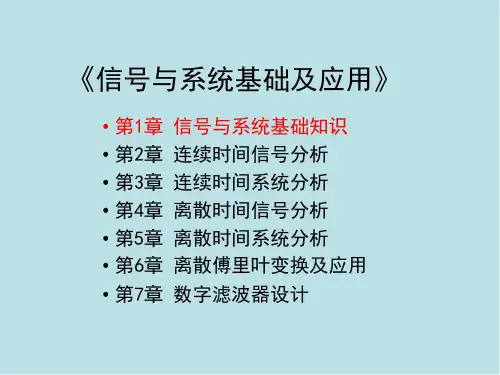
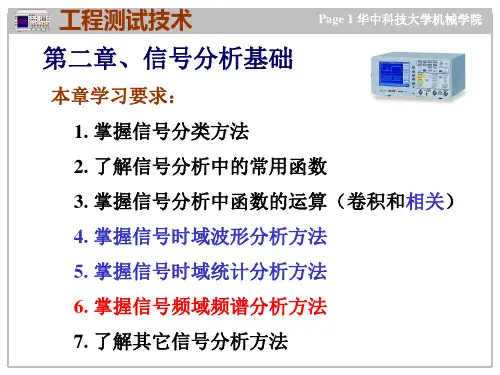
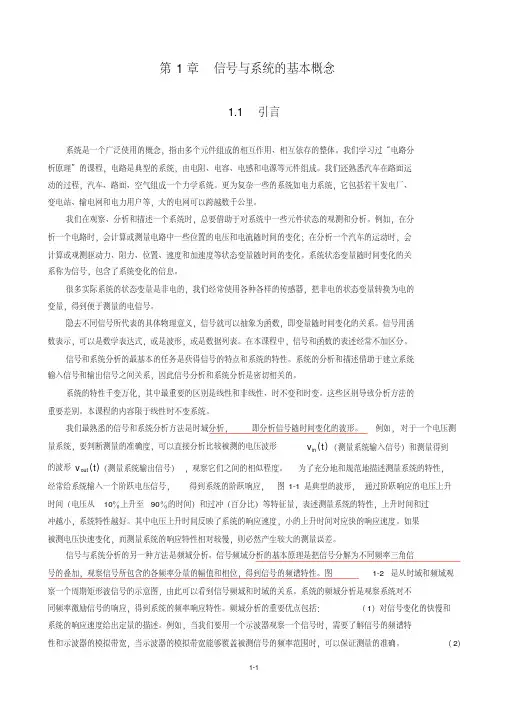
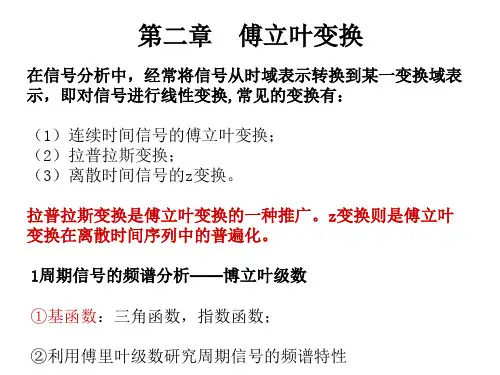
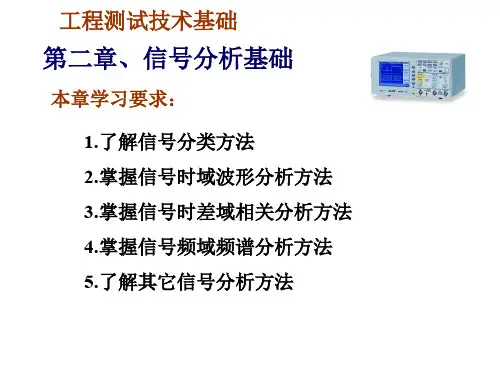
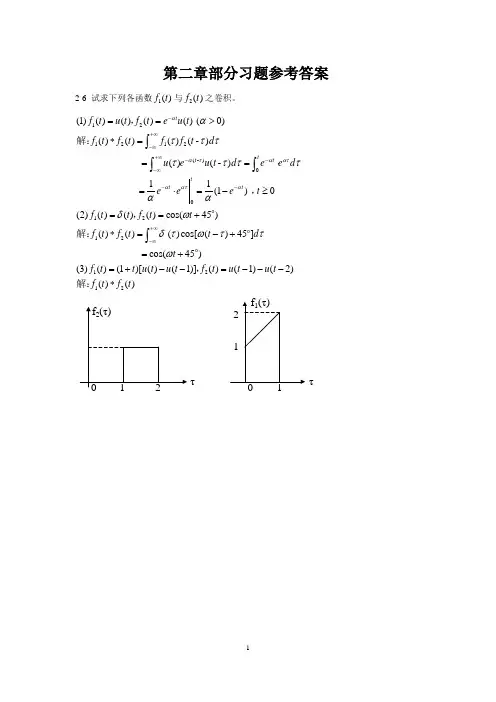
第二章部分习题参考答案2-6 试求下列各函数1()f t 与2()f t 之卷积。
121212(-)01(1) ()() ()() (0) ()()()(-) ()(-)11(1) 0(2) ()t tt t tt t f t u t f t e u t f t f t f f t d u eu t d e e d e e e t f t ααταατααταατττττττααδ-+∞-∞+∞---∞--==>*===⋅=⋅=-≥=⎰⎰⎰,解:,2121212() ()cos(45)()()()cos[()45] cos(45)(3) ()(1)[()(1)] ()(1)(2) ()()t f t t f t f t t d t f t t u t u t f t u t u t f t f t ωδτωττω+∞-∞=+*=-+=+=+--=---*⎰,解:,解:ττ222221211211()(-1)(-1)-2(-2)(-2)(-1)(-1)-(-2)(-2)2211-(-2)(-2)(-3)(-3)-(-2)(-2)(-3)(-3)22()*()()1,()0123, (1-)(1)21(1)--(12ttf t t u t t u t t u t t u t t u t t u t t u t t u t f t f t f t t f t t t dt t ft t t t τττ=+++=<=<<+=+-=++⎰222-112222212111)-222123, (1-)(1)-221()2(1)-2(1-)(-1)211121---152223, ()*()0.t t t t t t d t f t t t t t t t t t t t f t f t ττττ-+=<<+=+=+++=+++=++>=⎰121221--(4) cos , (1)-(-1)()*()()(-) [(1)-(-1)][cos(-)] cos[(1)]-cos[(-1)]f t t f t t t f t f t f f t d t t t d t t ωδδτττδδωττωω+∞∞+∞∞==+==+⋅=+⎰⎰ -212-212--2-220(5) ()(), ()sin ()()()*()()sin(-)(-) sin(-)sin t t ttt tf t e u t f t t u t f t f t f t e u t u t d e t d ee d τττττττττ+∞∞==⋅==⋅⋅⋅=⋅=⋅⎰⎰⎰-12-(-)--0022-(-)-33-2-3(6) ()2[()-(-3)], ()4()-(-2)0, ()0.02,()2488-825, 88()8(-)5, ()0.t tt t t tt t t t t f t e u t u t f t u t u t t f t t f t e d e e e t ft ed ef t e e e t f t ττττττ-==<=<<==⋅=<<===>=⎰⎰2-8 求阶跃响应为32()(21)()t t s t e e u t --=-+的LTI (线性时不变)系统对输入()()t x t e u t =的响应。
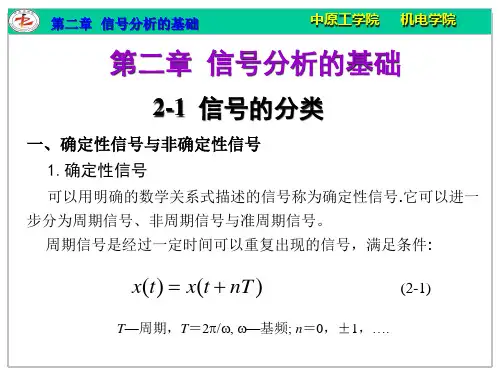
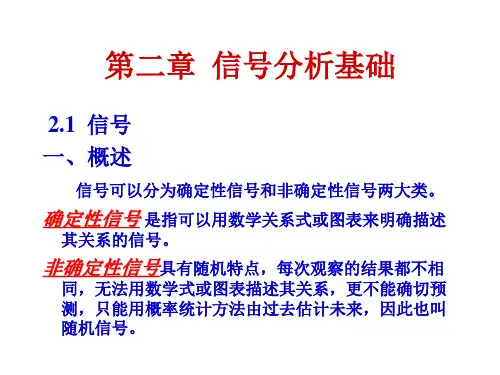
第二章 连续时间系统的时域分析2.1 系统模型为便于对系统进行分析,需要建立系统的模型,在模型的基础上可以运用数学工具对系统进行研究。
一. 模型:模型是系统物理特性的数学抽象,以数学表达式或具有理想特性的符号组合图形来表征系统特性。
由电路图可列出方程:dt t de C t i dt t di RC dtt i d LC t e t Ri dt t di L dt t i Ct)()()()()()()()(122=++=++⎰∞-即:这就是系统的数学模型。
二. 系统模型的建立是有一定条件的:1. 对于同一物理系统在不同条件之下,可以得到不同形式的数学模型。
(参考书中P29)2. 对于不同的物理系统,经过抽象和近似有可能得到形式上完全相同的数学模型。
(参考书中P29)建立系统模型只是进行系统分析工作的第一步,为求得给定激励条件下系统的响应,还应当知道激励接入瞬间系统内部的能量储存情况。
如果系统数学模型、起始状态以及输入激励信号都已确定,即可运用数学方法求解其响应。
一般情况下我们对所求得结果可以作出物理解释赋予物理意义。
综上所述,系统分析的过程,是从实际物理问题抽象为数学模型,经过数学解释后再回到物理实际的过程。
也即:建立数学模型解数学模型对解加于物理解释三. 时域分析方法时域分析:在分析过程中,所涉及到的函数都是时间的函数。
(1)经典方法:求解微分方程(2)卷积积分法(重点内容)2.2 线性时不变系统微分方程的建立分析对象:线性的、时不变系统(非时变系统)教学目标:熟练掌握建立线性系统的微分方程的方法。
重点:电路系统建立微分方程的基本依据。
难点:用网孔电流法及节点电位法列状态方程。
一.一. 电路系统建立微分方程的基本依据1.元件特性约束(电路元件的伏安特性)(1)电阻器:-R由欧姆定律:)( )()(1)(tiRtutuRtiRRRR⋅==或若电阻特性参数与时间无关,即R与流过电阻器的电流或施加的电压大小无关,则此电阻称为时不变电阻或线性电阻。
第一章数字信号处理概述简答题:1.在A/D变换之前和D/A变换之后都要让信号通过一个低通滤波器,它们分别起什么作用?答:在A/D变化之前为了限制信号的最高频率,使其满足当采样频率一定时,采样频率应大于等于信号最高频率2倍的条件。
此滤波器亦称为“抗混叠”滤波器。
在D/A变换之后为了滤除高频延拓谱,以便把抽样保持的阶梯形输出波平滑化,故又称之为“平滑”滤波器。
判断说明题:2.模拟信号也可以与数字信号一样在计算机上进行数字信号处理,自己要增加一道采样的工序就可以了。
()答:错。
需要增加采样和量化两道工序。
3.一个模拟信号处理系统总可以转换成功能相同的数字系统,然后基于数字信号处理理论,对信号进行等效的数字处理。
()答:受采样频率、有限字长效应的约束,与模拟信号处理系统完全等效的数字系统未必一定能找到。
因此数字信号处理系统的分析方法是先对抽样信号及系统进行分析,再考虑幅度量化及实现过程中有限字长所造成的影响。
故离散时间信号和系统理论是数字信号处理的理论基础。
第二章 离散时间信号与系统分析基础一、连续时间信号取样与取样定理计算题:1.过滤限带的模拟数据时,常采用数字滤波器,如图所示,图中T 表示采样周期(假设T 足够小,足以防止混叠效应),把从)()(t y t x 到的整个系统等效为一个模拟滤波器。
(a ) 如果kHz rad n h 101,8)(=π截止于,求整个系统的截止频率。
(b ) 对于kHz T 201=,重复(a )的计算。
解 (a )因为当0)(8=≥ωπωj e H rad 时,在数 — 模变换中)(1)(1)(Tj X Tj X Te Y a a j ωω=Ω=所以)(n h 得截止频率8πω=c 对应于模拟信号的角频率c Ω为8π=ΩT c因此 Hz Tf c c 6251612==Ω=π 由于最后一级的低通滤波器的截止频率为Tπ,因此对T8π没有影响,故整个系统的截止频率由)(ωj e H 决定,是625Hz 。